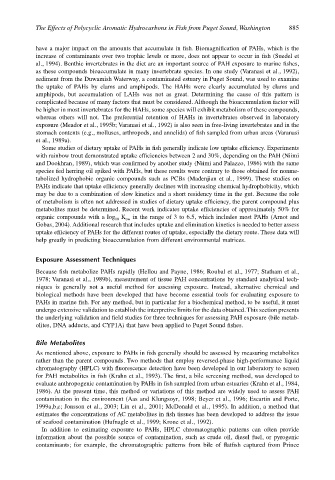Page 905 - The Toxicology of Fishes
P. 905
The Effects of Polycyclic Aromatic Hydrocarbons in Fish from Puget Sound, Washington 885
have a major impact on the amounts that accumulate in fish. Biomagnification of PAHs, which is the
increase of contaminants over two trophic levels or more, does not appear to occur in fish (Suedel et
al., 1994). Benthic invertebrates in the diet are an important source of PAH exposure to marine fishes,
as these compounds bioaccumulate in many invertebrate species. In one study (Varanasi et al., 1992),
sediment from the Duwamish Waterway, a contaminated estuary in Puget Sound, was used to examine
the uptake of PAHs by clams and amphipods. The HAHs were clearly accumulated by clams and
amphipods, but accumulation of LAHs was not as great. Determining the cause of this pattern is
complicated because of many factors that must be considered. Although the bioaccumulation factor will
be higher in most invertebrates for the HAHs, some species will exhibit metabolism of these compounds,
whereas others will not. The preferential retention of HAHs in invertebrates observed in laboratory
exposure (Meador et al., 1995b; Varanasi et al., 1992) is also seen in free-living invertebrates and in the
stomach contents (e.g., molluscs, arthropods, and annelids) of fish sampled from urban areas (Varanasi
et al., 1989a).
Some studies of dietary uptake of PAHs in fish generally indicate low uptake efficiency. Experiments
with rainbow trout demonstrated uptake efficiencies between 2 and 30%, depending on the PAH (Niimi
and Dookhran, 1989), which was confirmed by another study (Niimi and Palazzo, 1986) with the same
species fed herring oil spiked with PAHs, but these results were contrary to those obtained for nonme-
tabolized hydrophobic organic compounds such as PCBs (Madenjian et al., 1999). These studies on
PAHs indicate that uptake efficiency generally declines with increasing chemical hydrophobicity, which
may be due to a combination of slow kinetics and a short residency time in the gut. Because the role
of metabolism is often not addressed in studies of dietary uptake efficiency, the parent compound plus
metabolites must be determined. Recent work indicates uptake efficiencies of approximately 50% for
organic compounds with a log K in the range of 3 to 6.5, which includes most PAHs (Arnot and
ow
10
Gobas, 2004). Additional research that includes uptake and elimination kinetics is needed to better assess
uptake efficiency of PAHs for the different routes of uptake, especially the dietary route. These data will
help greatly in predicting bioaccumulation from different environmental matrices.
Exposure Assessment Techniques
Because fish metabolize PAHs rapidly (Hellou and Payne, 1986; Roubal et al., 1977; Statham et al.,
1978; Varanasi et al., 1989b), measurement of tissue PAH concentrations by standard analytical tech-
niques is generally not a useful method for assessing exposure. Instead, alternative chemical and
biological methods have been developed that have become essential tools for evaluating exposure to
PAHs in marine fish. For any method, but in particular for a biochemical method, to be useful, it must
undergo extensive validation to establish the interpretive limits for the data obtained. This section presents
the underlying validation and field studies for three techniques for assessing PAH exposure (bile metab-
olites, DNA adducts, and CYP1A) that have been applied to Puget Sound fishes.
Bile Metabolites
As mentioned above, exposure to PAHs in fish generally should be assessed by measuring metabolites
rather than the parent compounds. Two methods that employ reversed-phase high-performance liquid
chromatography (HPLC) with fluorescence detection have been developed in our laboratory to screen
for PAH metabolites in fish (Krahn et al., 1993). The first, a bile screening method, was developed to
evaluate anthropogenic contamination by PAHs in fish sampled from urban estuaries (Krahn et al., 1984,
1986). At the present time, this method or variations of this method are widely used to assess PAH
contamination in the environment (Aas and Klungsoyr, 1998; Beyer et al., 1996; Escartin and Porte,
1999a,b,c; Jonsson et al., 2003; Lin et al., 2001; McDonald et al., 1995). In addition, a method that
estimates the concentrations of AC metabolites in fish tissues has been developed to address the issue
of seafood contamination (Hufnagle et al., 1999; Krone et al., 1992).
In addition to estimating exposure to PAHs, HPLC chromatographic patterns can often provide
information about the possible source of contamination, such as crude oil, diesel fuel, or pyrogenic
contaminants; for example, the chromatographic patterns from bile of flatfish captured from Prince

